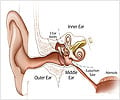A new study says that people who can change intonation in speech are more empathetic.
A new study says that people who can change intonation in speech are more empathetic.
The study found that people use the same brain regions to produce and understand intonation in speech.Many studies suggest that people learn by imitating through so-called mirror neurons.
The study was the first to show that prosody - the music of speech - also works on a mirror-like system.
And the researchers found that the higher a person scores on standard tests of empathy, the more activity they have in their prosody-producing areas of the brain.
So increased empathic ability is linked to the ability to perceive prosody as well as activity in these motor regions, said authors Lisa Aziz-Zadeh and Tong Sheng of USC, and Anahita Gheytanchi of the Pacific Graduate School of Psychology.
"Prosody is one of the main ways that we communicate with each other," said Aziz-Zadeh.
Advertisement
Or when talking to a pet: "If you have a pet, they basically are understanding your prosody," Aziz-Zadeh said.
Advertisement
The same part of the brain lit up when the volunteers heard the phrase as when they repeated it.
It is called Broca's Area and is situated about two inches above and forward of each ear.
The volunteers with the most activity in Broca's Area tended to score high on empathy measures.
They also used prosody more frequently in daily speech.
It is not clear whether empathy brings about prosodic activity or whether frequent use of prosody can somehow help to develop empathy - or whether there is no cause and effect relationship either way.
The study is published in the journal PLoS ONE.
Source-ANI
RAS










